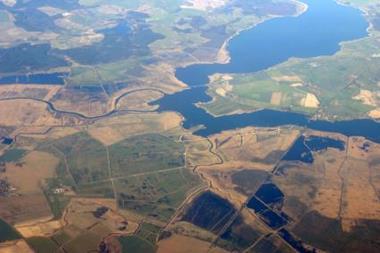Subsidence losses have been a hidden catastrophe for the insurance industry. UK buildings insurers have paid out a total of more than €8 billion since 1976, and the cost of claims in France since its inclusion in the Catastrophes Naturelles scheme in 1989 forced the government to increase insurance premium tax. By Rebecca Cheetham
The appearance of cracks in the walls of a house is a sight that owners fear. In many cases these cracks may not be a cause for alarm, but they could be an early warning of a deeper problem linked to the nature of the ground upon which the building has been constructed.
Subsidence commonly refers to the damage that can occur where buildings have been constructed upon an expansive soil. Soils that exhibit expansive properties owe their characteristics to the presence of swelling clay minerals that give the soil the capacity to shrink when moisture is extracted and to swell when moisture is absorbed. If a building foundation has been laid within such an expansive soil, the foundation and the building which it supports can be subjected to movement due to soil volume changes, which in some cases can result in serious structural damage.
Subsidence occurring as a result of expansive soil is strictly defined as the downward movement of the soil, taking with it the foundation and building superstructure, due to soil shrinkage caused by water loss. However, often damage that is attributed to subsidence is the result of the opposite process, when water previously lost, is re-absorbed by the expansive soil, causing swelling and upward movement. This movement is more correctly termed as “heave,” but in the context of this article, “subsidence” will apply to building damage caused by the shrinkage or expansion of clay-rich soils.
Physical factors
Geologically, soils with a clay mineral content of greater than 5% percent by weight will exhibit expansive properties and certain clay minerals, such as the smectite clay montmorillonite, give soils the most profound swelling properties. If such a soil is exposed to periods of drought interspersed with more humid conditions, cycles of soil shrinkage and swelling can occur, causing soil movements that can place a building foundation and superstructure under stress.
Other factors can aggravate an underlying subsidence problem by modifying the soil water content near a building foundation. These include underground water sources, such as leaking pipes, drains or swimming pools, or the presence of large tree roots or dense vegetation that extract water and result in local soil drying.
Structural damage
Damage to buildings on expansive soils can evolve over a number of years and is often recurrent. Initial signs of subsidence include cracks at weak points of the building structure, such as around doors and window frames. More serious damage that may develop over time includes the dislocation and cracking of structural elements, the distortion of building openings and the rupture of pipes. Such damage can be extensive and unsightly, and affect the usefulness of the structure. Maintenance and repair work can be substantial and are likely to be expensive.
Factors affecting building damage
The most extensive damage from subsidence occurs where differential movement occurs in the foundation soil. Such movements within building foundations re-distribute structural loads in a way not accounted for in the original design.
Differential movements within a foundation soil can be the result of variation in the moisture content of the soil from one part of the foundation to another. This commonly occurs around the edge of a building, which is more exposed to evaporation of water than the soil beneath the centre of the building; the soil around the periphery of a foundation shrinks and the external walls crack. Even if the water content in the soil beneath the foundation remains stable, the natural heterogeneity in the clay mineral content of the soil across the site can also cause differential movement.
Structures most vulnerable to subsidence damage include lightly loaded one or two floor buildings, such as detached houses and warehouses, or those without foundations, like pavements. They are less able to suppress the differential movement of a swelling soil than a heavy, multi-floor structure, for example blocks of flats and heavy industrial construction.
Where subsidence causes problems
Subsidence damage to buildings is fairly common and geographically widespread. According to research by the Association of British Insurers (ABI) in 2000, problems associated with foundation movement as a result of the presence of shrinkable/ expansive soils have been identified on a global scale, as illustrated on the map above.
In Europe, research using meteorological and soil mineral information to identify the subsidence hazard has shown that France, Spain, Denmark, Greece and the United Kingdom are at risk. Whether this hazard then translates into property damage and monetary loss depends upon many factors. These may be physical, such as the proximity of the hazard to the building stock and the building construction type, or cultural, such as the attitude of the general public towards subsidence damage and the insurance of it.
Insurance in the United Kingdom
Problems caused by subsidence in the United Kingdom mostly result from the drying and shrinkage of saturated clay soils caused by a period of drought, combined with the extraction of soil water by the roots of nearby vegetation, particularly those of large trees. Problems connected to heave are less common. The southeastern corner of the country is particularly prone to damage from subsidence due to expansive soils, of which those containing London blue clay are problematic.
Subsidence, landslip and heave have been included in UK building insurance policies since 1971. Initially subsidence was covered at no extra premium, but the exceptionally dry summer of 1976 resulted in many claims payments, followed by a progressive yearly increase in the numbers of claims, the cost of which peaked at around €800 million in 1991. Since 1976, buildings insurers have paid out a total of more than €8 billion.
Most policies are now subject to a large deductible, depending on the location of the risk, and there are numerous policy exclusions. Some highly exposed properties are hardly insurable. Until the early 1990s, underpinning was a common remedial measure, although costly, time-consuming and disruptive. Since then, insurers have preferred to monitor the development of cracks in a building structure before deciding whether major remedial works are needed.
More recent figures from the ABI have shown that UK subsidence claims over recent years have declined somewhat; between 2001 and 2007, the gross incurred claim cost ranged from a maximum of £408 million (€484 million at 30 November 2008 rates) in 2003, to a minimum of £162 million (€192 million) in 2007.
Subsidence insurance in France
In France, the subsidence problem stems predominantly from the shrinkage of saturated clay soils. Large parts of France have buildings that are constructed on shallow, un-reinforced foundations on expansive clay soils. Those areas particularly at risk from subsidence include northern France in the region Nord Pas de Calais, in the Loire around Tours and Orleans, around the suburbs of Paris and in the southwest around Toulouse.
Since 1982, insurance for all natural perils, except windstorms of “normal intensity” has been incorporated into all household insurance policies under the Catastrophes Naturelles scheme, financed by a tax of 12% on all household insurance premiums. Insurance companies can either keep this tax, in which case they must pay all natural peril-related losses, or pass on a proportion of it to the state reinsurer, the Caisse Centrale de Réassurance (CCR) in return for reinsurance coverage. The French government gives the CCR an unlimited guarantee.
Subsidence was first incorporated into the Catastrophes Naturelles scheme in 1989, and in the 10 years that followed, it became the second most costly natural peril in France after flood. Subsidence claims for the period between 1989 and 2003 can be estimated at over €4.5 billion, based on figures from the CCR, which corresponds to many hundreds of thousands of households in France filing claims. The cost of these losses compelled the government to increase the premium tax from 9% to the present 12% to help fund claim payments.
Modelling the peril
Most efforts to model subsidence on clay soils use information on soil type, vegetation coverage and, perhaps, climatic information to give certain postcodes, or individual buildings, a subsidence risk rating. UK insurers in particular use this approach to quantify their exposure to possible subsidence-related losses.
Such models differ in their complexity and resolution. Some use national soil type maps or geological databases, containing information on the susceptibility of different parts of the country to ground movements caused by subsidence. Such models can be used to give postcodes individual risk ratings. Others focus on the influence of large trees in proximity to buildings on subsidence-prone soil types. Aerial photography and light detection and ranging (LIDAR) can establish the proximity of trees to buildings, their height and canopy size, from which it is possible to determine the present and future area of the tree root zone. Such models can be used on a finer scale, giving a subsidence risk assessment for an individual property.
More detailed tools also take climatic information into account, which allows tracking of the intensity of soil drought throughout summer months at specific locations. This information can be used in combination with soil type maps that identify the shrinkage capacity of clay soils at depths relevant to the location of residential building foundations to provide a final ground subsidence rating at a relevant geographical scale.
Building a model
The probabilistic modelling of subsidence due to expansive clay soils has received little attention in comparison to rating models that identify areas at risk from the peril. In 2005, Guy Carpenter’s European Model Development Team embarked on a project to produce a probabilistic subsidence model for France, to address the gap which exists in the availability of modelling solutions for this peril in the country.
Our probabilistic subsidence model incorporates detailed information of the subsidence hazard across France, combined with a sophisticated event set, a model of France’s built environment and its vulnerability to damage from expansive clay soils. The model enables the elucidation of the subsidence hazard that exists in different areas of the country and quantification of the potential damage caused to vulnerable buildings by a range of subsidence events of varying intensity.
Future subsidence
Current predictions of the future climate suggest changes in precipitation extremes and the future occurrence of drought, which are likely to affect the extent of subsidence in Europe. Current climate projections suggest that Mediterranean regions will show significant reductions in summer soil moisture content and experience an overall decrease in annual precipitation. Central and Eastern European areas are also likely to experience more temperature extremes and less summer precipitation.
However, for north western Europe’s maritime areas (coastal areas of northern continental Europe and United Kingdom), an overall increase in winter precipitation, increased river flow and a higher risk of coastal flooding are expected. In the United Kingdom, as with most countries in the higher latitudes, temperature increases above that of the global mean are likely to accompany these changes. Greater summer warming and a shift in rainfall patterns could mean a decrease in summer rainfall in London and southeastern parts of the United Kingdom by 20 – 40%, resulting in more severe summer droughts and greater associated subsidence costs. The ABI, however, believes that potential losses from other climate related perils, such as coastal flood, are significantly greater than those likely from a severe subsidence event.
Postscript
Rebecca Cheetham is part of Guy Carpenter’s European model development team. She is
based in Paris.
rebecca.cheetham@guycarp.com
www.guycarp.com

















